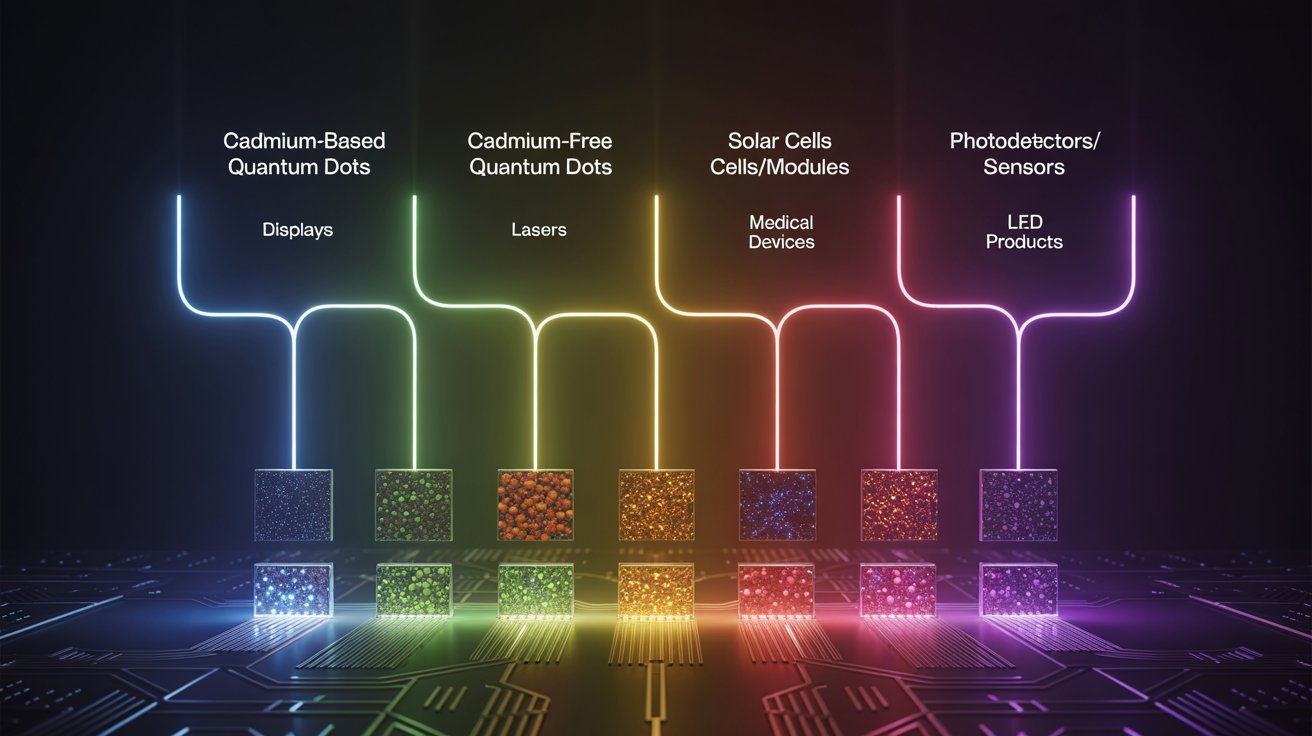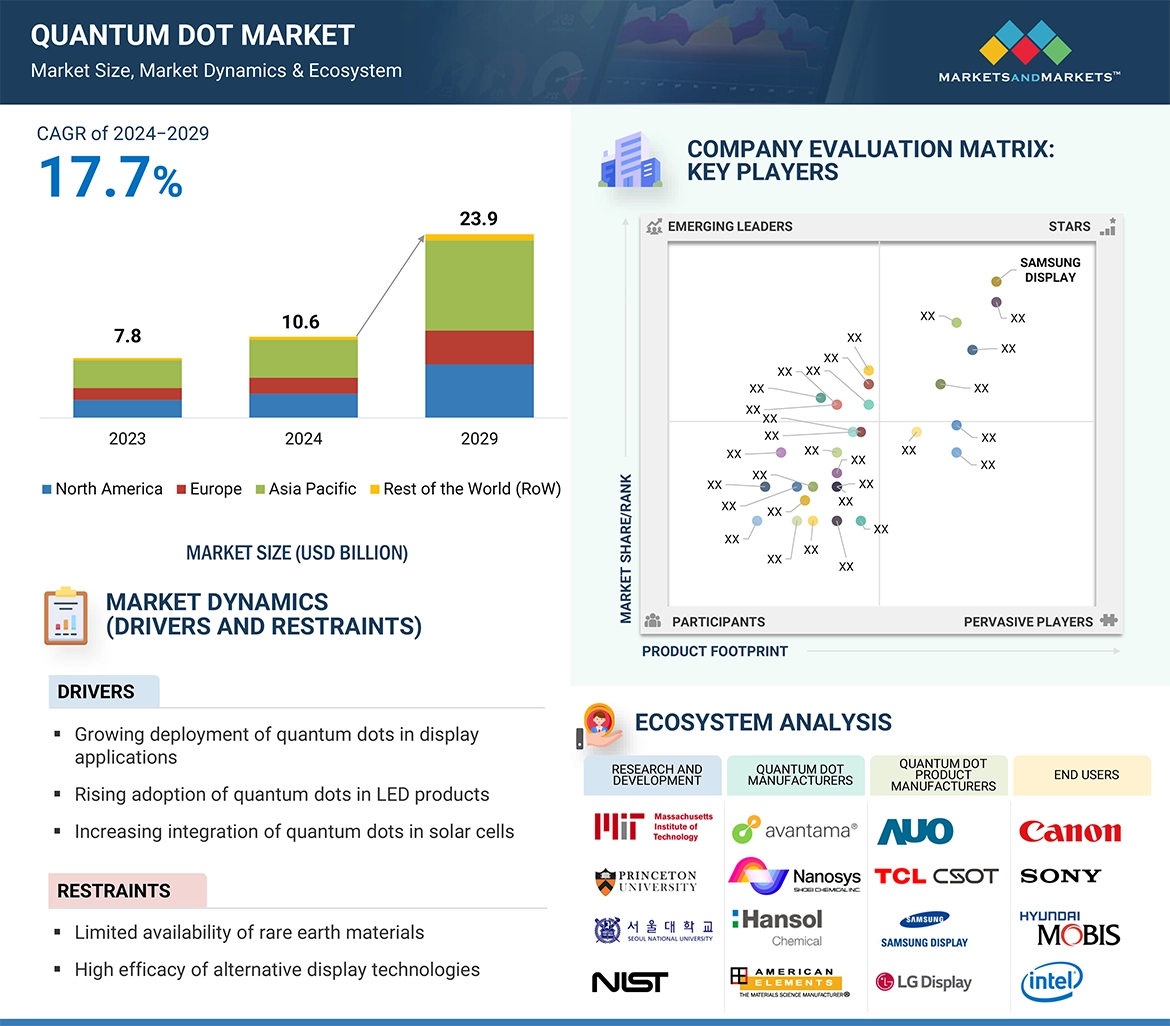The Quantum Dot Market is entering a period of accelerated expansion, supported by rapid technological advancements, rising demand for high-performance displays, and increasing adoption across consumer electronics, healthcare, automotive, and lighting industries. As quantum dots transition from niche components to mainstream enabling materials, market players are deploying strategic initiatives to strengthen their competitive positioning and capture emerging opportunities. The global outlook for the quantum dot market reflects continuous innovation, diversification of applications, and the evolution of manufacturing techniques that are making quantum dots more scalable, cost-efficient, and environmentally compliant. With these developments, the industry is poised to achieve significant growth in the coming years.
Download PDF Brochure @ https://www.marketsandmarkets.com/pdfdownloadNew.asp?id=694

Key players in the quantum dot market include established technology manufacturers, material suppliers, and leading consumer electronics brands that integrate quantum dots into their product lines. Companies such as Samsung Electronics, LG Display, Nanosys, Quantum Materials Corp., Nanoco Group, and OSRAM Opto Semiconductors are at the forefront of innovation. These players are investing heavily in research and development to improve quantum dot performance, enhance brightness efficiency, and extend material lifespans. They are also pushing advancements in next-generation display architectures such as QD-OLED, QD-microLED, and electroluminescent quantum dots, which are expected to reshape the future competitive dynamics of the display industry.
Strategic partnerships and collaborations represent a core component of the market’s growth strategy. Material suppliers are forming alliances with display manufacturers to accelerate the adoption of quantum dot enhancement films and color conversion layers in televisions, monitors, and laptops. These partnerships help streamline production, reduce material costs, and ensure consistent quality. In addition, several companies are pursuing cross-industry collaborations, particularly in automotive, lighting, and medical imaging sectors, to expand the scope of quantum dot applications beyond consumer electronics. This multi-sector approach strengthens value chains, enhances market reach, and supports long-term sustainability.
Another major strategic focus is the shift toward cadmium-free quantum dots, driven by stringent environmental regulations and rising consumer demand for eco-friendly technologies. Leading players are investing in indium phosphide-based quantum dots and other alternative materials to comply with global standards such as the European Union’s Restriction of Hazardous Substances (RoHS) directive. The development of high-performance cadmium-free formulations is a key differentiator in the market, enabling companies to appeal to environmentally conscious buyers and expand into markets with strict regulatory environments. This transition is expected to define the competitive landscape in the next decade as sustainable innovation becomes central to corporate strategy.
Inquiry Before Buying @ https://www.marketsandmarkets.com/Enquiry_Before_BuyingNew.asp?id=694

Manufacturing advancements are also shaping the quantum dot growth roadmap. Efforts to scale production and improve fabrication efficiency are driving cost reductions, which in turn are accelerating market penetration. Companies are exploring new synthesis methods, automated production lines, and printable quantum dot inks that support flexible and large-area display manufacturing. These innovations are enabling mass-market deployment and opening doors to emerging display form factors such as foldable screens, transparent panels, and wearable interfaces. Improved manufacturing scalability is expected to be one of the strongest enablers of quantum dot market expansion beyond 2025.
In terms of market growth roadmap, display technologies will continue to dominate the quantum dot landscape, driven by strong demand for high-brightness, wide-color-gamut televisions, monitors, and professional screens. Quantum Dot LED (QLED) displays remain a major revenue generator, while the commercialization of QD-OLED and EL-QLED technologies is projected to unlock new revenue streams. The transition from enhancement film-based solutions to self-emissive quantum dot displays represents a long-term growth trajectory as companies focus on delivering superior contrast, faster response times, and improved energy efficiency.
Healthcare and biomedical applications also form a critical element of the market’s future roadmap. Quantum dots’ ability to emit precise wavelengths makes them ideal for bio-imaging, diagnostic assays, and targeted drug delivery research. As medical technologies continue to evolve toward more accurate and minimally invasive methods, quantum dots will play an increasingly important role in enhancing detection capabilities and improving clinical outcomes. This sector is expected to see robust growth as regulatory approvals increase and research institutions expand their use of nano-enabled diagnostic tools.
View detailed Table of Content here – https://www.marketsandmarkets.com/Market-Reports/quantum-dots-qd-market-694.html

Automotive and industrial applications offer additional growth avenues. As vehicles become more digital and autonomous, quantum dots are being integrated into automotive displays, lighting systems, and augmented reality interfaces. Their superior brightness and stability under varying environmental conditions make them ideal for both interior and exterior vehicle components. Meanwhile, industrial lighting and specialty illumination markets are adopting quantum dot-enabled solutions to achieve higher energy efficiency and tailored spectral output.
Looking ahead, the quantum dot market’s growth roadmap is defined by ongoing innovation, deeper vertical integration, and expanding application diversity. The convergence of material science breakthroughs, sustainable design priorities, and rising demand for premium display performance is setting the stage for strong long-term growth. Key players that strategically invest in cadmium-free materials, scalable manufacturing, and cross-industry partnerships will be best positioned to lead the market. As quantum dot technology continues to evolve, it is set to become a foundational component of next-generation electronics, lighting, healthcare, and automotive systems, shaping the future of advanced materials and global innovation.

